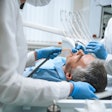
KANSAS CITY, Kansas (Reuters) - It's a sacrifice some people make by living in the wide-open spaces: nobody to take care of their teeth.
A shortage of dentists in rural Kansas and other states has left residents with little to smile about. A coalition formed in Kansas is pushing for legislative reforms to attract dental professionals, if not dentists themselves, to underserved areas.
Kansas has no dentists in 14 of its 81 counties, leaving those residents with a choice of taking long drives or ignoring their teeth. The first option is expensive and time-consuming, the latter is ill-advised by dentists and doctors.
"Dental care is about more than just teeth, it's about the whole body," said Stephanie Mullholland of a health care advocacy group called Kansas Action for Children.
Poor care of teeth and gums can lead to infections detrimental to the heart and lungs while contributing to diabetes, strokes, low birth weights, and other conditions, according to the surgeon general of the U.S.
The shortage of dentists is national in scope. Part of a recent $130 million package of health care grants announced by the Department of Health and Human Services includes $4.3 million for dental workforce needs in underserved regions.
The shortage in rural Kansas is traced to multiple factors. Dentists shy away because of low rates of reimbursement for Medicaid patients, who are numerous in rural areas. Salaries are lower in rural regions. Kansas has no dental school. Finally, the average age of dentists in Kansas is 50. When they retire in rural areas, young dentists don't replace them.
Largely unsuccessful in prior efforts to lure more dentists to rural Kansas, the coalition called the Kansas Dental Project is now pushing for state legislation to allow licensing of "dental therapists" who would not only clean teeth but do extractions and fillings.
They would work under the supervision of dentists, although the dentists may be in distant offices.
Dental therapists could help address the dentist shortage the way licensed practical nurses filled a need in the 1950s and 1960s for medical care in areas without doctors, Mullholland said.
"We use midlevel providers extensively on the medical side," said Cathy Harding, executive director of the Kansas Association for the Medically Underserved.
"Dental therapists care for patients in the same way on the dental side." Dental therapists are used in Alaska and in more than 50 foreign countries, she said.
Various states have taken different approaches.
Maine voters just approved a $5 million bond issue to build the state's first dental school and help dental clinics around the state. Other states have tried mobile dental clinics, offered college tuition and salary incentives for would-be dentists, and set up bistate tuition and license reciprocity agreements.
By Kevin Murphy
Last Updated: 2010-11-24 16:39:06 -0400 (Reuters Health)
Copyright © 2010 Reuters Limited. All rights reserved. Republication or redistribution of Reuters content, including by framing or similar means, is expressly prohibited without the prior written consent of Reuters. Reuters shall not be liable for any errors or delays in the content, or for any actions taken in reliance thereon. Reuters and the Reuters sphere logo are registered trademarks and trademarks of the Reuters group of companies around the world.



















